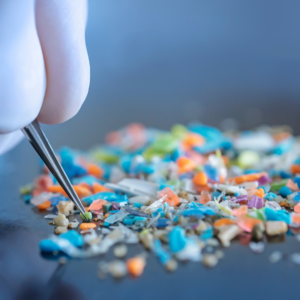Microplastic analysis of materials found in our environment has become a priority to understand their potential impacts on human health. Most characterisation techniques face many challenges due to the nature of the microplastic samples. This article outlines the need for more research into microplastics and how Raman microscopy offers unique advantages for microplastic analysis and identifying the chemical composition of the material.
The awareness around the negative impacts of plastic pollution in our waterways has grown rapidly in the past few years. Images of turtles caught in plastic bags or seabirds tangled in fishing wire are widely spread with cries to turn off the so-called plastic tap, representing the tons of plastic waste dumped into our oceans every day.

Figure 1: Plastic pollution washed up on a beach.
In these cases, we can clearly see the problem. We can pick up the plastic that floats down rivers or washes up on beach shores and dispose of it responsibly. However, there is more than meets the eye. As plastic floats in the ocean it is exposed to sunlight, worn against waves and suffers from wind abrasion. This causes large pieces of plastic to break into smaller pieces. Over time, the pieces become so small they can’t always be seen by the human eye. This is what is known as a microplastic.

Figure 2: The Lifecycle of Microplastics and how they can end up being consumed by humans.
As microplastics enter the water, they are mistaken by marine life as food and, when eaten, accumulate within fish. When humans consume seafood, they also consume microplastics. Microplastics have additionally been found in drinking water, soil, in Antarctic ice and even drifting in the air.1 The full extent of the danger posed to humans by microplastic is unknown. This is partly because of the difficulties involved in microplastic analysis.
Common methods for microplastic analysis have many challenges when it comes to identifying samples of ocean microplastics. This includes background interference such as water, and of course the very small sample size. In recent years, Raman Spectroscopy has been found to be a key technique in identifying the chemical composition of ocean microplastics. Coupling the Raman spectrometer with a confocal microscope allows us to visualise tiny particles, helping to create a clearer picture of the material and potential harmful impacts on humans.
Due to its high spatial resolution, Raman microscopy for microplastic analysis allows the smallest particle size to be examined. This is important as the human gut can only absorb particles smaller than 150 µm so being able to investigate samples of this size is vital when researching the impacts of plastic on human health. Raman spectroscopy can be used to analyse samples as small as 1 µm in diameter with the latest research studying the possibility of measuring the even smaller nanoplastics.2
Water interference is another common issue in many analytical techniques, such as Fourier Transmission Infra-Red Spectroscopy (FTIR). However, the signals from water molecules are very weak in Raman spectra, meaning wet samples can be more accurately analysed. Background fluorescence can often interfere with sample reading, masking important characteristic peaks and making plastics difficult to identify. However, the RM5 from Edinburgh Instruments offers Confocal Raman Microscopy with a selection of up to 3 lasers, reducing the interference and improving the quality of spectra.

Figure 3: Key steps taken during Microplastic Analysis using the RM5 Raman Microscope.
Raman microscopy is proving to be a vital method for microplastic analysis. Its ability to investigate such small samples and utilise multiple laser wavelengths to avoid background interference make the technique hugely advantageous as we further our understanding of how microplastics impact in our environment and potentially could impact human health.

Figure 4: RM5 Raman Microscope
Edinburgh Instruments offers Raman Microscopes that can help with microplastic analysis by identifying the chemical composition of microplastics, and therefore study the impact on human health. If you are interested in learning more about our instruments, please contact our sales team who will be happy to help you.
Are you interested in other applications of our Raman Spectrometers? Sign up to our newsletter below for the latest Application Notes from Edinburgh Instruments.




